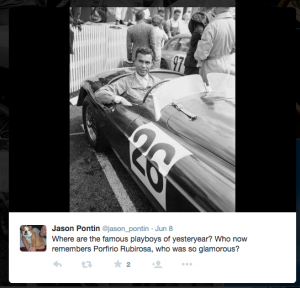It’s been over fifty years since “the glamorous” Porfirio Rubirosa last graced the international night scene with his Dominican charm, yet many are still reminiscing on the life and times of the famous playboy. Porfirio Rubirosa Ariza, known by family, friends and close acquaintances as “Rubi,” was born January 22nd, 1909 to Pedro Maria Rubirosa (a general) and Ana Ariza Almanzar (the granddaughter of a Spanish general) in San Francisco de Macorís, Dominican Republic. A Dominican by chance and a Parisian by choice, Rubi would become the most infamous playboy of the 20th century. Between 1932 and 1965, Rubi married five times and maintained numerous affairs with the world’s wealthiest and most famous women–most notably, Zsa Zsa Gabor. Regarded as the great “Latin Lover” of the 20th century, Rubi is best remembered for his charisma, charm and Creole handsomeness. But how did Rubi, a non-White Dominican man with no particular skills (acting, business or otherwise), come to enjoy the highlife appreciated by Frank Sinatra, Aly Khan and the like?
Prof. Paravisini-Gebert and Prof. Woods-Peiro attempt to answer this question in their forthcoming e-book, Porfirio Rubirosa: Race, Masculinity and Mobility. In assisting them with this research, I’ve learned that Rubi was an exception to the rule- though most obviously a person of mixed race, Rubi was not understood to be Black. During a time when race served as a basis for discrimination and genocide in both the U.S. and Europe (though it still does today), Rubi managed to marry four White, non-Dominican women: Danielle Darrieux, Doris Duke, Barbara Hutton and Odile Rodin. The racialization of Rubi as Latin rather than Negro was particularly crucial for his social mobility: it allowed him to pass as non-Black and thus, gave rich, White women the green light. Though Rubi was well aware of his own Blackness–he often sported Panama hats and protected his face with honey–his race was hardly noted by the press. In fact, Langston Hughes observed: “So I have not seen in the colorful obituaries of the late Rubirosa in the American press, any reference to race. Had he been an American citizen by birth, the headlines probably would have read: NEGRO PLAYBOY DIES.”
Rubi was not only exoticized because of his race, however. He was also rumored to possess an appreciable genital endowment. Indeed, his first wife, Flor de Oro Trujillo (El Jefe’s daughter and Rubi’s only Dominican wife), confessed that “In time, he began to make love to me in different ways, but when it was over my insides hurt a lot” (Levy 2005:48). The rumours and whispers of this endowment contributed to Rubi’s hyper-masculinization–if there had been any doubts about Rubi’s masculinity, and in particular his ability to please women, Flor’s and other women’s anecdotes confirmed his tíguerismo. It also helped that Rubi was sporty and interested in the fast life–he was an avid polo player and a terrible race car driver, but a race car driver nonetheless. Having led a fast, dangerous life [both socially (he was named in several divorce cases and involved in various crimes) and physically], many have deemed Rubi’s 1965 car crash death “a fitting end.” Fifty years later, however, Rubi’s charisma and playboy ways have gone unmatched and it seems that many are still asking, where are the glamorous playboys of yesteryear?
On page 10 of The Last Playboy, Shawn Levy explains “The Dominican tíguere was, like the ideal male in all Latin cultures, profoundly masculine…He was handsome, graceful, strong and well-presented…He could move with sensuality or violence.” He goes on to say, “indeed, it was widely understood in Dominican life that an element of tíguerismo was essential to most success.”
Levy, Shawn. The Last Playboy: The High Life of Porfirio Rubirosa. New York: HarperCollins, 2005. Print.


